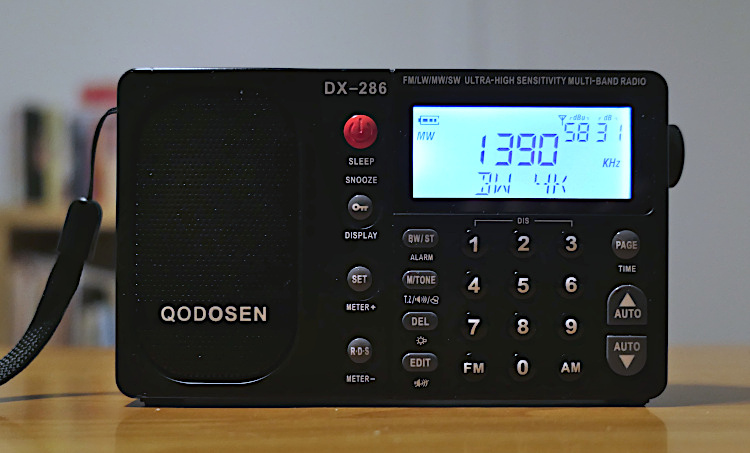
Introduction
There has been wide acclaim for the Qodosen DX-286 AM/FM/shortwave radio, but one of the features that has created some adverse reactions are the bandwidth filters available for listening to AM or shortwave broadcasts.
Note that this article doesn't cover the Qodosen's FM bandwidth filters, which offer an unusually broad set of choices for FM listening. More details on the FM bandwidth filters are in the main review of the DX-286.
Also note that, for AM and shortwave listening, bandwidth settings will affect the frequency response and audio quality, which is why it's important to strike a balance between selectivity and audio quality. There is a trade-off between the two.
Many radio models in this class offer a range of bandwidth filters, from wide filters for higher audio fidelity to narrow filters to reduce interference to a station from adjacent stations. The Qodosen also offers four bandwidth filters on AM (including shortwave), but does not have as broad a range of choices compared to radios such as the XHDATA D-109, the XHDATA D-808 (also known as the Digitech AR-1780), or the Tecsun PL-310ET, PL-320, or PL-380.
The Qodosen DX-286 offers four filter choices, nominally ranging from 3 to 8 kHz. The default, shown above, is 4 kHz. The BW/ST button is used to choose among the bandwidth settings.
Particularly for shortwave listeners (few though they may be), this set of choices has caused some grumbling. It doesn't bother me. A 3 kHz bandwidth is the minimum that works for me in being able to have an intelligible broadcast. What I especially like to see are wider bandwidths that make AM broadcasts more pleasant to listen to.
The Qodosen company has explained in online groups dedicated to the radio that the bandwidths on offer are those provided by the NXT TEF6686 chip that powers the DX-286.
This article examines the AM bandwidth filters in detail. In at least two instances, I find that the filter settings don't appear to be as wide as they're claimed to be. This may be due to limitations of the NXP TEF6686 chip that powers the radio, but I don't know for sure.
Methodology
To determine the audio bandwidth passed by each of the bandwidth filters, I fed a sweep tone that was digitally generated through a Part 15 AM transmitter. This is a legal form of very low-power AM operation that probably doesn't even cover a city block. But it's good enough for within a house.
There are limitations to this approach. The frequency response of the transmitter has never been measured, and I don't have specifications for it. I'm assuming that it has a flat frequency response up to the present-day limit for AM radio of 10 kHz, but I don't know that for sure. I've also noticed that the frequency response of the sweep tone isn't entirely flat. There's a slight roll-off at about 100 Hz, which I'm not worried about for the purposes of these tests. The response at higher frequencies also tends to roll off a bit. I wish I had a better setup, but it's adequate for most purposes.
Consequently, I didn't feel I could apply the standard test used in stereo receiver reviews of the 1970s and 1980s, where there was simply a measurement of the low-frequency and high-frequency points at which the AM frequency response was down 6 dB. Some additional interpretation was required.
For these tests, I looked at the frequency response curve as indicated by the Audacity audio editing program, and looked for the frequency at which there was a sudden drop-off in response followed by a consistent slope of the curve, until that slope became gentler. The concept is similar to that of an inflection point. When you see the graphs from Audacity, I think the concept will become clearer. I also listened to program material to see how each of the filters function in practice. So let's look at the graphs!
3 kHz bandwidth
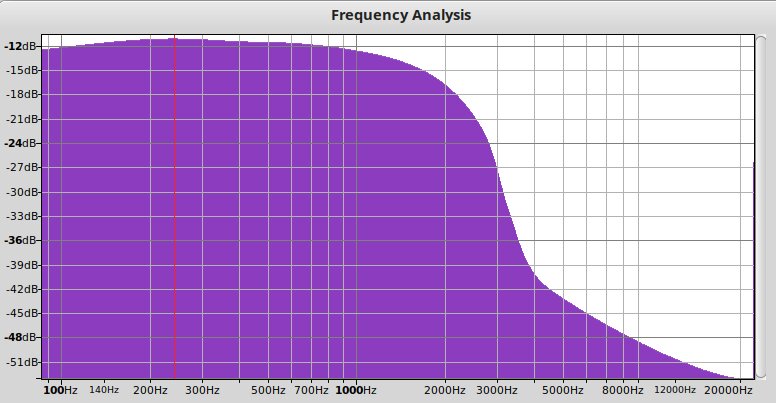
This is the narrowest AM bandwidth position available on the DX-286. The response curve as measured in Audacity indicates that this designation is pretty accurate. It looks like the "inflection point" for the curve is close to 3 kHz. On a more impressionistic basis, the audio at this position is lacking high-frequency audio yet is still understandable. That's especially true for spoken-word programming, which has a more restricted frequency response compared to music. Result: indeed, this is a 3 kHz filter.
4 kHz bandwidth
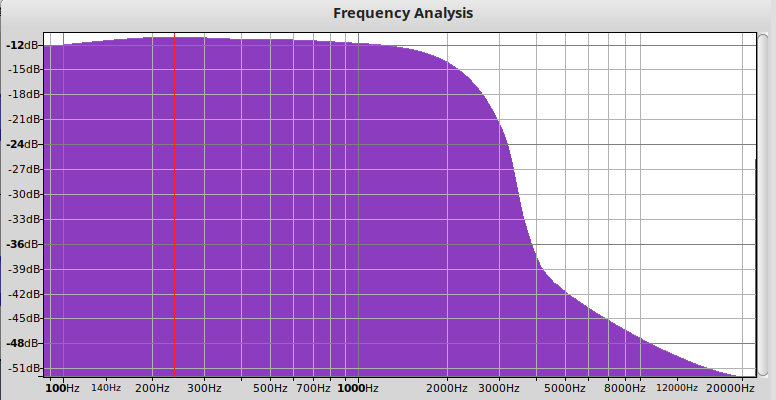
The 4 kHz bandwidth filter is the default position for AM or shortwave listening to which the Qodosen resets itself whenever the radio is turned on. The "inflection point" here is somewhere around 3.7 kHz. The audio sounds like the audio for a typical AM radio, with relatively little treble but with enough crispness for pleasant listening to spoken-word programming. Result: It's not quite a 4 kHz filter but I think it's a bit better than a 3.5 kHz filter, so I've settled on calling it a 3.7 kHz filter, based on the inflection point that I observed.
6 kHz bandwidth
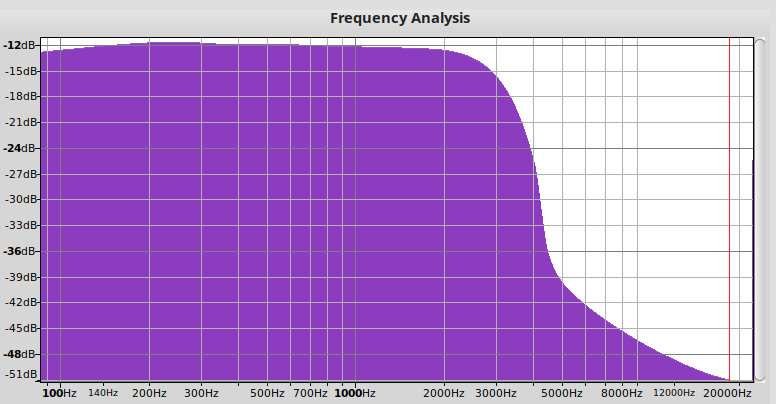
Now we're getting into interesting territory. A 6 kHz bandwidth should be friendlier to music than the first two, though you'd still never confuse it for high fidelity. The "inflection point" on a steeper curve than the first two filters appears to be around 4.3 or 4.4 kHz. But the higher end of the audio seems to have more punch than this curve would indicate. Result: I'll call it a 4.5 kHz filter.
8 kHz bandwidth
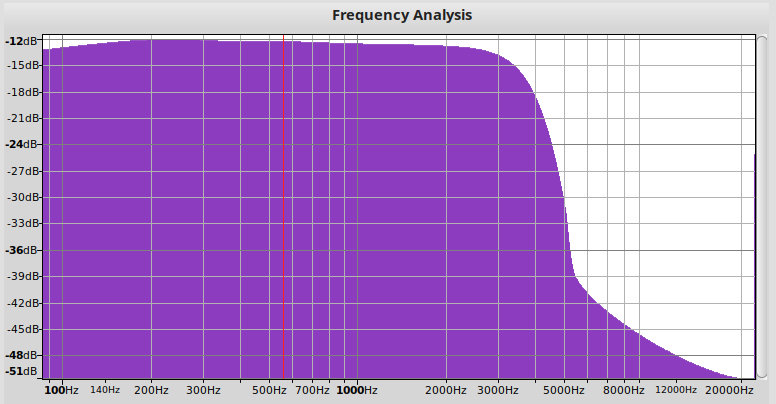
This is the widest AM bandwidth option available on the DX-286. A 8 kHz, only the highest octave of the music spectrum should be missing. However, in listening to music and voice at this setting, it seemed like more was missing. Looking at the frequency graph, you see that the inflection point of the frequency response is right at 5 kHz. Audio at this setting sounds very similar to the AM audio in the Sangean HDT-1X tuner, which I've measured to have a sharp cutoff at 5 kHz. That said, the Qodosen does not suffer from the distortion, exemplified in a ringing sound, that the HDT-1X seems to have. (Note that my review of the HDT-1X from the 2010s appears to have been lost. Or maybe I never wrote one to begin with. Anyway, I may re-review it at some point in 2025.) Result: I feel pretty confident that this is a 5 kHz filter; it might be 5.5 kHz at most.
Summary and conclusion
To summarize my interpretation of the results:
| Claimed bandwidth | Observed bandwidth |
|---|---|
| 3 kHz | 3 kHz |
| 4 kHz | 3.7 kHz |
| 6 kHz | 4.5 kHz |
| 8 kHz | 5 kHz |
While the Qodosen DX-286's bandwidth filters are versatile, they appear to offer a narrower range of choices than the radio itself indicates. I believe the top AM frequency response is 5 kHz, not 8. The lower bandwidth settings are more accurate. The one for 3 kHz is on-target and the filter for 4 kHz is somewhat close to target.
The Qodosen's default AM bandwidth setting is 4 kHz, which strikes a reasonable balance of selectivity and audio fidelity. Considering the state of AM radio in 2025, heavily dependent upon spoken-word programming, this is good enough for many purposes. Slightly wider bandwidths are available, and they will sound better, but they still can't be considered high fidelity.
More on the Qodosen DX-286
» The official concise reference for the DX-286's functions and controls
» Comparing performance of the DX-286 with similar radios
» Back to the Qodosen DX-286 review